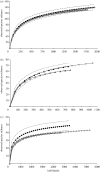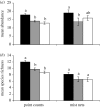Degraded lands worth protecting: the biological importance of Southeast Asia's repeatedly logged forests
- PMID: 20685713
- PMCID: PMC2992721
- DOI: 10.1098/rspb.2010.1062
Degraded lands worth protecting: the biological importance of Southeast Asia's repeatedly logged forests
Abstract
Southeast Asia is a hotspot of imperiled biodiversity, owing to extensive logging and forest conversion to oil palm agriculture. The degraded forests that remain after multiple rounds of intensive logging are often assumed to be of little conservation value; consequently, there has been no concerted effort to prevent them from being converted to oil palm. However, no study has quantified the biodiversity of repeatedly logged forests. We compare the species richness and composition of birds and dung beetles within unlogged (primary), once-logged and twice-logged forests in Sabah, Borneo. Logging had little effect on the overall richness of birds. Dung beetle richness declined following once-logging but did not decline further after twice-logging. The species composition of bird and dung beetle communities was altered, particularly after the second logging rotation, but globally imperiled bird species (IUCN Red List) did not decline further after twice-logging. Remarkably, over 75 per cent of bird and dung beetle species found in unlogged forest persisted within twice-logged forest. Although twice-logged forests have less biological value than primary and once-logged forests, they clearly provide important habitat for numerous bird and dung beetle species. Preventing these degraded forests from being converted to oil palm should be a priority of policy-makers and conservationists.
Figures





Similar articles
-
The conservation value of South East Asia's highly degraded forests: evidence from leaf-litter ants.Philos Trans R Soc Lond B Biol Sci. 2011 Nov 27;366(1582):3256-64. doi: 10.1098/rstb.2011.0031. Philos Trans R Soc Lond B Biol Sci. 2011. PMID: 22006966 Free PMC article.
-
Reduced-impact logging and biodiversity conservation: a case study from Borneo.Ecol Appl. 2012 Mar;22(2):561-71. doi: 10.1890/11-1362.1. Ecol Appl. 2012. PMID: 22611854
-
Selective‐logging and oil palm: multitaxon impacts, biodiversity indicators, and trade‐offs for conservation planning.Ecol Appl. 2014;24(8):2029-49. Ecol Appl. 2014. PMID: 29185670
-
Navjot's nightmare revisited: logging, agriculture, and biodiversity in Southeast Asia.Trends Ecol Evol. 2013 Sep;28(9):531-40. doi: 10.1016/j.tree.2013.04.005. Epub 2013 Jun 11. Trends Ecol Evol. 2013. PMID: 23764258 Review.
-
Biodiversity loss in Latin American coffee landscapes: review of the evidence on ants, birds, and trees.Conserv Biol. 2008 Oct;22(5):1093-1105. doi: 10.1111/j.1523-1739.2008.01029.x. Conserv Biol. 2008. PMID: 18759777 Review.
Cited by
-
Do riparian reserves support dung beetle biodiversity and ecosystem services in oil palm-dominated tropical landscapes?Ecol Evol. 2014 Apr;4(7):1049-60. doi: 10.1002/ece3.1003. Epub 2014 Mar 5. Ecol Evol. 2014. PMID: 24772282 Free PMC article.
-
Social and Environmental Impacts of Forest Management Certification in Indonesia.PLoS One. 2015 Jul 1;10(7):e0129675. doi: 10.1371/journal.pone.0129675. eCollection 2015. PLoS One. 2015. PMID: 26132491 Free PMC article.
-
The conservation value of South East Asia's highly degraded forests: evidence from leaf-litter ants.Philos Trans R Soc Lond B Biol Sci. 2011 Nov 27;366(1582):3256-64. doi: 10.1098/rstb.2011.0031. Philos Trans R Soc Lond B Biol Sci. 2011. PMID: 22006966 Free PMC article.
-
The impact of selective-logging and forest clearance for oil palm on fungal communities in Borneo.PLoS One. 2014 Nov 18;9(11):e111525. doi: 10.1371/journal.pone.0111525. eCollection 2014. PLoS One. 2014. PMID: 25405609 Free PMC article.
-
The impact of logging roads on dung beetle assemblages in a tropical rainforest reserve.Biol Conserv. 2017 Jan;205:85-92. doi: 10.1016/j.biocon.2016.11.011. Biol Conserv. 2017. PMID: 28133389 Free PMC article.
References
-
- Myers N., Mittermeier R. A., Mittermeier C. G., da Fonseca G. A. B., Kent J.2000Biodiversity hotspots for conservation priorities. Nature 403, 853–85810.1038/35002501 (doi:10.1038/35002501) - DOI - DOI - PubMed
-
- Sodhi N. S., Koh L. P., Brook B. W., Ng P. K. L.2004Southeast Asian biodiversity: an impending disaster. Trends Ecol. Evol. 19, 654–66010.1016/j.tree.2004.09.006 (doi:10.1016/j.tree.2004.09.006) - DOI - DOI - PubMed
-
- Curran L. M., Trigg S. N., McDonald A. K., Astiani D., Hardiono Y. M., Siregar P., Caniago I., Kasischke E.2004Lowland forest loss in protected areas of Indonesian Borneo. Science 303, 1000–100310.1126/science.1091714 (doi:10.1126/science.1091714) - DOI - DOI - PubMed
-
- Hansen M. C., et al. 2008Humid tropical forest clearing from 2000 to 2005 quantified by using multitemporal and multiresolution remotely sensed data. Proc. Natl Acad. Sci. USA 105, 9439–944410.1073/pnas.0804042105 (doi:10.1073/pnas.0804042105) - DOI - DOI - PMC - PubMed
Publication types
MeSH terms
LinkOut - more resources
Full Text Sources
Other Literature Sources

